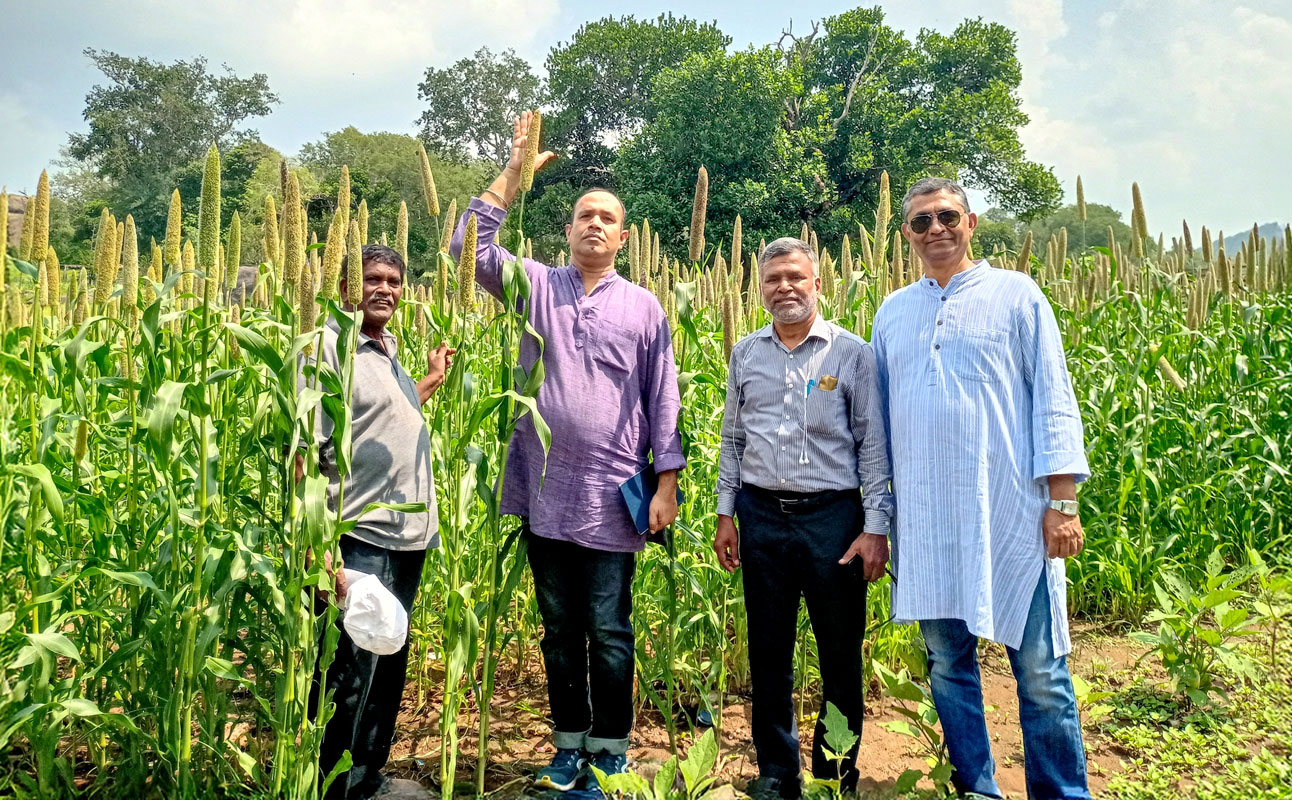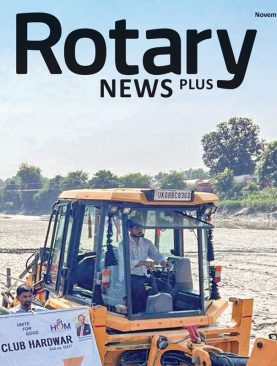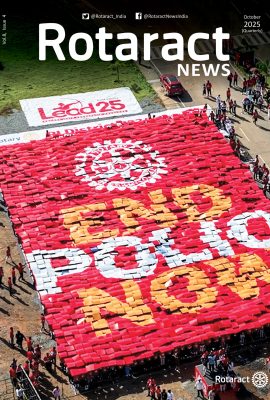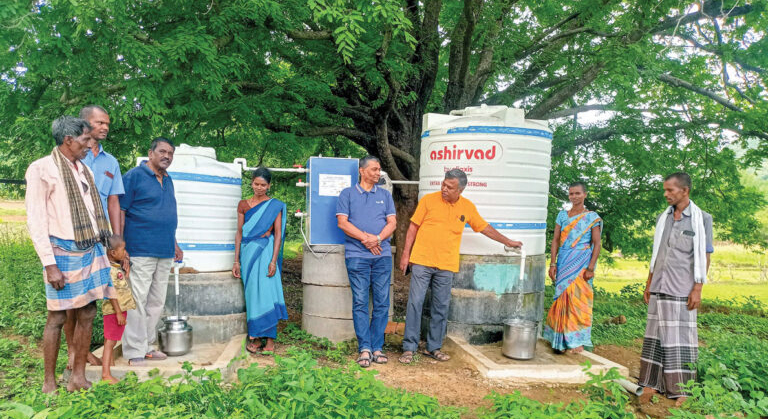Imagine a scenario when you have to switch off all the lights and fans in your house in order to have enough voltage to run the motor to fill your overhead tank. As power supply is erratic and inadequate, even though many houses in this area do have overhead water tanks, they are rarely used. While most hamlets have power, it is only single phase. The reliability of such power is also a question mark, due to the power outages and the low voltage. And if and when power goes, which is mostly during the rainy season, it won’t be restored for days, as the terrain becomes slushy and very difficult to reach.

We are talking about the villages in the Jawadhu Hills in Tamil Nadu, which are an extension of the Eastern Ghats, with many parts reaching an altitude of 3,800ft in this tribal belt, hardly 250km away from Chennai, but presenting a very challenging hilly terrain to implement community welfare projects. In this difficult area, a small but dedicated band of Rotarians from Chennai are carrying out a transformational project to improve lives and livelihoods, nutrition levels, children’s education, and easier availability of water for household use and drinking.
The hamlets in this visually beautiful and verdant green region are home to about 100,000 indigenous tribal people. There are 11 panchayats and 229 hamlets within a 150sqkm radius. The hills get good rainfall, but the hilly terrain means most of the water runs off as there are no big-ticket water conservation efforts. Tribal women face a huge challenge in fetching water from the source which might be up or down from their homes. With no extensive or desirable road network, and availability of schools only in the bigger hamlets, even basic education for the children is a challenge.
In the villages which have no school, parents take their children to the villages where the forest department’s schools are available, and leave them there for five days of the week.
To cut to the chase, the socio-economic conditions of the struggling tribals of Jawadhu Hills have resulted in a strong partnership between a few Rotarians in the then RI District 3232, cutting across clubs, that has led to a mega project on which ₹1.3 crore has been spent till now. In March 2023, with the objective of improving the lives of tribals in Jawadhu Hills, a survey was conducted by a three-member team comprising past president of RC Chennai Mitra S Saiseshan, a retired Indian Forest Service officer V Irulandi, and S Seshadri, the secretary of IFTR (Indigenous and Frontier Research Centre), a non-profit research organisation working with the then RID 3232. Rotary tied up with the IFTR as it aims to accelerate the use of modern science and technology for the development interventions to improve the livelihoods of people who need help.
As a first step, the team visited Jawadhu Hills to assess the ground realities and identify the gaps in the development process to take up possible interventions. The team visited a few villages in the Jamunamarathur, Polur and Melpattu ranges and interacted with the tribal people. The Rotarians also went to the schools run by the Forest department and the Tamil Nadu Education department.

Based on this initial field visit and study done by this small team, the IDEAL Jawadhu (Infrastructure Development, Environment, Energy and Education, Agriculture, Livelihood) project was initiated, with IFTR being the implementing agency and the Rotary Clubs of Chennai Mitra and Alandur being the anchor clubs.
The venture’s CSR partner is the AMM Murugappa Chettiar Research Centre (MCRC) at Jamunamarathur, with the Forest department being an important partner and stakeholder. Saiseshan explains that as Irulandi had retired as a senior official of the Forest department, it was easy for him to get the support and cooperation of forest officials. “The meeting kickstarted various activities and IDEAL Jawadhu is now a landmark project of RID 3234 (after 3232 was split) and the anchor clubs now are RCs Chennai Mitra and Chennai Green City,” says Saiseshan. Irulandi has now joined RC Chennai Green City, and the key anchor from IFTR, Seshadri, is a member of RC Chennai Akshaya. The project is on for nearly two years.
Water management
He explains that even though the height is good enough to get good rainfall, and the higher reaches are clothed in green, due to lack of storage facilities the summer months resemble an arid region. Agriculture is the main activity and most of the people can be classified as small or marginal farmers. With the water availability being poor around the year, “they do not get good yield of crops. Hence, many go as labourers to different places, including Kerala and Karnataka to work in coffee, tea and rubber plantations.”
The shortage of water, particularly in the summer months, results in poor hygiene and sanitation, adversely affecting the health of the local people. The remote unscalable location, combined with lack of healthcare and poor transportation facilities, leads to high rates of morbidity and poor life expectancy.

The Rotarians soon tackled the water problem to save women the difficult trek to fetch water home. While the larger homes have their own wells, the smaller homes and farms share common village wells. To help the villagers, solar pumps were provided, connected to mini tanks placed closer to the hamlet. The water pumped into the larger tank is used for cleaning and bathing, while the smaller tanks make available filtered water for drinking and cooking. The filtration is through Tata Swachh filters placed between the two tanks. This has been done in 15 villages and this is a big help to the women.
Next on the cards are check dams; wanting to ascertain that these will work in a hilly terrain and how they should go about this aspect, water management experts at the Anna and Madras Universities have been consulted. “If they are interested, we’ll take them to the region and see what can be done.”
Education
A good percentage of the tribal population here is still illiterate, even though some of the youngsters have managed to graduate with a few even completing their postgraduate education. While key villages or hamlets are accessible by black-topped roads, many hamlets continue to have only mud roads which are accessible only on two-wheelers or by walk. Many of the villages do not have their own schools, which means that often the children have to walk for about 5km to reach the elementary schools being run by the forest department. Thanks to the provision of daily breakfast and noon meal, the enrolment in schools is going up steadily.

“But owing to the distance, and the poor job market even after completing UG degrees, there is a lack of confidence in the minds of people to send their children for higher education. More so in the case of girl children. Most of them study only up to Class 8, as most Forest department run schools are only up to the eighth class. The higher secondary schools are even further away and the parents are unwilling to let girl children go long distances by walking,” explains Saisehan.
The thirst for some basic education among parents is such that in the villages which have no school, parents take their children to the villages where the Forest department’s schools are available, and leave them there for five days of the week. During the weekends, the parents take their children back home, and the whole routine is repeated come Monday.
When they interact with the children the Rotarians find that the children don’t have much idea of what the world is like outside this hilly terrain. If you ask the children what they want to become after completing their education, they either say government (no classification or designation) or police.
We do what we can, but at every level we need government permission, which really delays things, but where permission is not needed, things are put in place quickly.
Forget learning through computers, most schools do not even have a TV. In some of the schools the government has given TVs; “where smart TVs are available, we are pushing learning through technology.”
The Rotarians have also made a representation to the government on improving road connectivity, so that access to schools can improve, particularly for girls. One spinoff from the phenomenon of pulling girls out of schools after Class 8 is that parents are in a hurry to get their daughters married. Another problem of schools being far-flung is that teachers are frequently absent, further deteriorating the quality of education.

Saiseshan explains that when the children are expected to stay in what are virtually boarding schools for five days — they go home only during the weekends — they are bored. So to make their evenings interesting, “in four places we’ve given smart TVs, and in other places we’ve given chess and carrom boards so that they can play some games.” The chess and carrom boards were funded by A Rajasekaran, a member of RC Chennai Gems. In one school, where there was a drinking water problem, a water tank and a solar pump were put up.
He adds that improved infrastructure will speed up development; “obviously we can’t lay roads, so we’ve reached out to the higher-level government officers. We do what we can, but at every level we need government permission, which really delays things, but where permission is not needed, things are put in place quickly.”
Healthcare
Bad road connectivity also has a huge impact on the health of this tribal population which suffers from high rates of morbidity and mortality. In most villages, explains Irulandi, even PHCs are absent. “The tribals must mostly come to Jamunamarathur, the largest hamlet in Jawadhu Hills, for treatment. Those who suffer the most include the old and the infirm, and in emergencies, they have to be carried to wherever medical care is available. You can imagine what happens during emergencies.” Most pregnant women get admitted at least a week to 10 days in advance, just to avoid the last minute complications due to bad roads making travel slow.
Farming and livelihood
Most of the tribal population in this belt comes under the BPL (below poverty line) category. Farming is their hereditary profession, and most of it is done during the monsoon rains, except for those who can afford to have their own wells for irrigation. There are no check dams and water is a major problem during summer. Rainwater is not harvested due to the hilly terrain.

With migration during summer months being common, this is a profitable market for money lenders from outside who visit the place, find jobs for people and lend money on interest, most of which is spent on liquor. Apart from erratic availability of water, the other challenges farmers face include pre- and post-harvest processing, storage, marketing, infrastructure, and so on. Some collect non-timber forest produce and grow a variety of trees including tamarind, jackfruit, coconut, lemon, plantain and gooseberry on their land.
Recently, the government and a few private organisations have started promoting farm produce companies/cooperatives such as the Jawadhu Hills Tribal Farm Produce Company, which was formed in 2020. But the gap in marketing persists, with the tribal farmers selling their produce to marketing agents from the plains at non-profitable rates.
These tribals who were growing and earlier consuming millets, were now selling it to agents and consuming rice brought from the PDS system, adversely impacting their nutrition.
Irulandi says opportunities are available to help the farmers improve their income through innovative approaches such as introduction of climate-resilient farming, interventions in soil quality improvement and moisture conservation, efficient usage of water and water conservation, introduction of improved crop varieties that can better withstand drought conditions, production of livestock feed and better nutrition.
“Adoption of climate resilient technologies will help sustain the ecosystem, like use of solar power for irrigation, solar lighting and even solar based post-harvest processing,” he adds.
While the tribals earlier consumed the millets grown by them, these days they sell huge quantities of millet and buy rice from the PDS system, as over the years rice-eating habit was encouraged by the government in schools. Ironically, with eating rice being perceived as superior to millet consumption, some farmers have started cultivating paddy, apart from maize, gherkins, cotton, and other horticulture crops.

As the urban elite find more health and nutritional value in millets and switch over from rice and wheat to millets, “we found that these tribals who were growing and earlier consuming millets, were now selling it to agents and consuming rice brought from the PDS system, adversely impacting their nutrition. Hence we have started giving them iron-fortified hybrid pearl millet seeds after counselling them that the produce harvested should be used for their own consumption,” says Saiseshan.
R ID 3234 DG N S Saravanan sums it up neatly when he says that IDEAL Jawadhu is “a flagship tribal empowerment project of RID 3234. Around ₹1.3 crore have already been spent on various interventions like providing solar panel and pumps, water tanks with purifiers, solar street lights, solar lamps for homes, TLUD (smoke free) stoves, iron-fortified hybrid millet seeds for farmers, spectra dryers for value addition to farm products, smart TVs for after school education, carrom and chess boards for Forest Middle Schools, and more.” The solar street lights come with sensors, that switch on or off automatically based on the light conditions. They also sense movement and adjust brightness accordingly. This way power is conserved and available for longer duration.
Spectra dryers were handed over at some villages for drying moringa leaves and selling them as powder, which fetches a better price.
He says this project has already touched the lives of tribal people in around 30 villages impacting 1,800 families. “I’ve personally visited Jamunamarathur and a couple of other hamlets, and can vouch for the impact that is being created in the lives of these people in the hills. I’m happy that past president Saiseshan from my home club, RC Chennai Mitra, is leading this project, along with past president Irulandi, a retired senior IFS officer, from RC Chennai Green City. Both of them have worked very hard on this project which is giving the desired impact.”
Saravanan added that this will be a long-term project for the district and as it is scaled up, more and more clubs will get involved. DGE Vinod Saraogi and DGN Suresh Jain have promised continued support. “This is also a wonderful example of Rotary working with CSR funds, the government, Forest department, local bodies and other NGOs specialising in the agri/ecology space. We are grateful to MCRC and IFTR for their valuable partnership and support.”

Seshadri adds that other initiatives include providing smokeless stoves; 75 have been given in two villages so far. Under the income enhancement plan, spectra dryers were handed over at some villages for drying moringa leaves and selling them as powder, which fetches a better price.
To prepare the youth for a better future, the Jawadhu IDEAL team has launched a joint initiative with the Jamunamarathur range of the Forest department. As a government job is the dream of many tribal youth, clearing the TNPSC examination is essential, and hence over 100 youth were coached by external trainers and the Forest department staff. RCs Madras Industrial City and Chennai Metrozone participated in this programme along with the anchor clubs RCs Chennai Mitra and Chennai Green City
Work is underway in identifying space for a Digital Training Centre and STEM and Basic Sciences Lab, for which AT&T, through a Bengaluru Rotarian, has donated some laptops. TN special secretary (forests) has promised to provide space.
Saiseshan says the Forest department identified the villages and “introduced us to the heads of local bodies, who helped with approvals for the solar projects. CSR support came from MCRC, Grundfos and AT&T. The installation of solar lights and pumps were taken care of by Sunlit Future, while the Open Mentor Trust and IIT-M Pravartak stepped in for education.”
Genesis of the project

Asked about the genesis of this transformational and all-encompassing project, Saiseshan says, “I wanted to do something for the tribals, and around that time I met Irulandi, a Rotarian who is a retired IFS officer. Since he retired from a top post in the forest department, when he calls, people respond, and in that area you can’t do much without support from locals. He used his Forest department contacts to identify and take us to remote villages which most needed our support.”
That is how the initial villages were identified after which the project team identified a young horticultural graduate to work with them, at a monthly salary of ₹10,000 paid by the IFTR.
As for future plans, now the team wants to establish a digital centre, given that their exposure to technology and technological tools for learning is very limited. “We’ve spoken to one of the professors in IIT-Madras to see if he can help us establish a stem lab in Jamunamarathur, which is not very remote and the only place which has the required internet connectivity. Sometimes when we go inside you can’t even reach us,” he smiles.
The millet story
Saiseshan, who is the CSR chair for RC Chennai Mitra and district chair for special initiatives, points out an interesting aspect when he says that the Jawadhu Hills are one of the hotbeds for millet cultivation in Tamil Nadu. They grow pearl, Foxtail, little and finger millets. Earlier the tribals also had the seeds of Kodo and Proso millets, which were grown widely.

But during the medical camps they conducted, the project leaders found that these villagers suffered from iron deficiency. “So we gave them iron- fortified hybrid millet seeds, which they planted and is growing very well there… the stalks are taller than me,” grins Saiseshan. Now the IFTR will conduct a study on its impact and suggest further course of action. He adds that it’s a pity that the locals have moved away from millets to rice, because millets now fetch an attractive price as the well-to-do urbans have started consuming them. “They are selling the millets because they get higher prices as people like us now want to consume millets… it is a commercial decision but nutritionally not that great. Once we found this, we are trying to educate them.”
The idea is not to stop them from selling millets and making more money, but to find a way by which they can grow more millets and consume a part of their produce and sell the rest. Other ways to boost their farm produce is by adequate innovations and interventions such as village climate risk management committees, community seed and fodder banks, climate adapted cultivation systems, crop diversification and increased cropping intensity.






